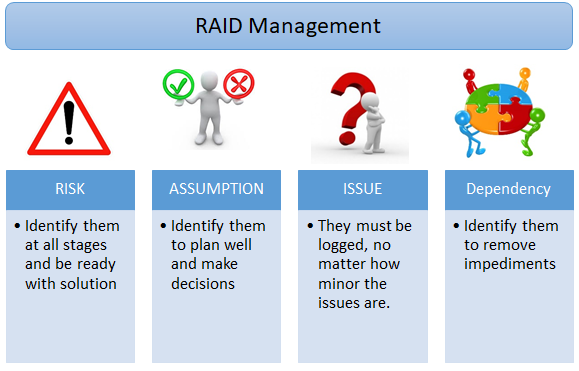You must have started thinking of RAID technology which is used worldwide for data storage. Hold on! It also has a different meaning in another important area of software engineering. RAID stands for Risks, Assumptions, Issues, and Dependencies. RAID is an acronym which should be at the forefront of your mind if you are a project manager or a program manager.
Why RAID?
Before delving into the details of the RAID, let’s see what benefits it brings to the table. It is a project planning technique that allows the stakeholders to ensure that project is well planned and monitored. It is not meant to replace any of the agile and lean tools but is only an enabler for effective project management.

RAID Management
Risks
- Project risks are the “issues” waiting to happen.
- This is the one key area PMs do take focus upon in the managing and mitigating of risks.
- All risks should be logged, no matter how small. All risks should be owned by someone who has been involved in the discussion about the specific risk.
- In the risk log section, there should be columns for the risk owner, status, and any dates that may be relevant.
Assumptions
- An assumption is something that is set as true to enable an organization to go ahead with a project.
- As part of the initial planning phase and project brief, assumptions are identified and documented.
- Unfortunately, many times they are just forgotten after this first activity.
- The purpose of tracking assumptions is you need to be ready for your assumptions being wrong.
- Most project plans are produced on this assumption, but if this assumption turns out to be false, then the project will falter.
Issues
- An issue is something that is going wrong in a project, is current and have yet to be properly addressed.
- Issues differ from risks in that they exist as a problem today, unlike risks which might turn into issues in the future.
- Like risks, issues need to be managed through an agreed management process.
- An issue is anything which arises on your project which you have to deal with to make sure your project runs smoothly.
- As with risks and actions, all issues should have an assigned id, owner, and timescale.
Dependencies
- Dependencies exist when an output from one task or another project is needed as a mandatory input for another task or another project. It can be direct and or indirect dependencies.
- It is a key responsibility for project managers to record, monitor, and manage these dependencies.
- Poor management of project dependencies often leads to project failure.
- The dependencies log will capture at least who the project is dependent upon and what they should deliver and when.
- PM’s should also keep details of the actual agreement and when it was made, plus any later variations of this.
RAID logs are one of the key tools that a program or project manager uses to keep themselves sane. You can refer sample Raid log example [link]
Related Links:
Related Keywords
Agile Manifesto, Waterfall, Iterative, Development Practice
